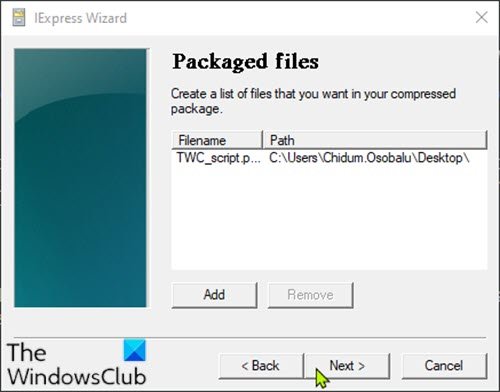

- #Iexpress post install commands how to
- #Iexpress post install commands zip file
- #Iexpress post install commands update
- #Iexpress post install commands Pc
- #Iexpress post install commands windows 7
then Next, No restart then Next, Save this file if you want this is just the config file for iexpress, then Next and Finish. Show window I use Hidden then Next, Finished Message No message then Next, Save this package as sepinstall.exe AND MAKE SURE you check the box store files using long file name inside package. \ In the post install command you will want: powershell ".\SEPinstall2.ps1" Then hit Next Hit Next, Under install program to launch you want this: SymantecIns.exe -s -d. You will also want to include SEPInstall2.PS2. If you followed my earlier instructions it should be called SymantecINS.exe. In THIS package you will want your Symantec EXE that you made. HERE is where you will put the files you want to package. Just hit Next, Next, Name the Package title whatever you want, Next, Next Start -> Run -> iexpess if you are not familiar iexpress packages your items as a single EXE> This script will Kick off the install of SEP and wait for it to finish, then delete your firewall rule so that the computer that is getting installed can talk to everything again. Netsh advfirewall firewall delete rule name="iptoblock-#001"
#Iexpress post install commands Pc
#Iexpress post install commands zip file
I have attached a zip file to this post with 2 scripts in it. We are going to want to package that EXE with a few powershell scripts to do what we want to do. Please if you are not familiar with powershell feel completely free to ask me questions, but you are going to have to have some kind of background in scripting. Press that button and it should turn your zip file into a new EXE file.

When you do that there is a button all the way to the rigth that says SFX. After you have that zipped file, Open it up in WinRAR (there may be ways to do this without downloading winRAR but I only know winRAR). Next, Working with the folder that actually holds the files (probably called Symantec Endpoint Protection 11 or something like that).
#Iexpress post install commands how to
If you need to know how to do this please ask and I will find a post that explains it.
#Iexpress post install commands update
To update the def you need to update the vdefhub folder in the install package that you just exported from SEPM. If you want you can update the virus Def prior to doing this. First thing I did was export my install package of SEP 11 (DO NOT export as a single EXE.

This will give you some downtime on the system, but will also keep the system safe if you have virus activity on the network while you reinstall. Put in a firewall rule that allows ONLY me to talk to that pc.So let me map out my idea for you of what I needed to do:
#Iexpress post install commands windows 7
I tried to use the EXE's that come with SEPM and I tried to use the Symantec product SEP Prep which is supposed to uninstall any anti virus product but it also did not seem to work very well.įirst things first: All of my systems are running either Windows 7 or Server 2008 R2 so this will not work for you 2003 or xp users unless powershell is installed. Finally, I wanted a single EXE that I could push to new clients for an install if need be. The other thing that I need was to be able to prevent any virus's from being able to attack the system while I was downgrading. I had a lot of clients that had this installed and I really did not want to downgrade every single system manually. This is going to be a long post, but if you are trying to downgrade (or you can use this for an upgrade) it is VERY helpful.īackstory: I was trying to find a good way to downgrade to SEP 11 remotely because I was not very happy with SEP 12. Just wanted to give the community a little help here.


 0 kommentar(er)
0 kommentar(er)
